Conference Presentations by Suman Thapa

Background and Aims
Childhood eating habits become behaviors lasting until adulthood and most of ... more Background and Aims
Childhood eating habits become behaviors lasting until adulthood and most of the research has also shown that children in Denmark are not eating recommended daily intake (RDI) of fruits and vegetables (FV). The study aims to identify the determinants promoting or preventing consumption of FV among 5-12 year-old multi-national students in an after school program (ASP) at Østerport International School, Copenhagen, Denmark.
Methods
Using a pre-test/post-test experimental study design, 53 children of ages 5 to 7 and 8 to 10 years old from 18 different countries were randomly selected for study. The food frequency questionnaires (FFQ) were administered before and after two-weeks nutrition education intervention. Children lunches were observed and recorded for one week before and after the nutrition education intervention. Some pre-test questions were repeated during the post-test, while others were not repeated in the post-test due to a lack of resources and time on the part of the researchers.
Results
The FFQ showed that 47% children consumed FV due to family influence and knowledge, 49% due to taste preferences (likes/dislikes), 34% due to school environment and 28% due to peer group, . Among all the determinants, availability and attitude were shown to have less influence on the consumption of FV (11%). There was no evidence that repeated taste-testing of new FV resulted in children consuming more FV.
Conclusions
Nutrition education intervention can be important tool to promote FV consumption in school and to address the several factors preventing them to eat more FV in their daily life
Papers by Suman Thapa

Psychology in the Schools, 2008
Rates of childhood overweight1 have reached epidemic proportions (U.S. Department of Health and H... more Rates of childhood overweight1 have reached epidemic proportions (U.S. Department of Health and Human Services, 2001), and schools have been called on to play a role in the prevention of this medical condition. This article describes a multiyear health promotion effort-the Athletes in Service fruit and vegetable (F&V) promotion program-which is based on social learning theory for urban, elementary school children in kindergarten through third grade. Children participate in the program for a period of 3 years. The goals of the program are to increase opportunities for children to be more physically active during the school day and to help students increase their F&V consumption. This article describes the F&V promotion components of the program that were implemented in year 1, including implementation integrity and treatment acceptability data. Year 1 evaluation data demonstrated that the program is acceptable from the perspective of school staff and was implemented by school staff with high levels of integrity. Hallmarks of the program's successful implementation and high acceptability include (a) having a school-based program champion; (b) designing the program to include low-cost, attractive, interactive materials; (c) including many school staff members to facilitate a culture of healthy eating in the school; and (d) spreading out implementation responsibilities among the multiple staff members so that each individual's involvement is time efficient. Rates of childhood overweight have reached epidemic proportions (U.S. Department of Health and Human Services, 2001). National data indicate that 19% of children and 17% of adolescents are overweight (Centers for Disease Control and Prevention, 2007b). These rates have tripled since 1980. Children who are poor and from certain minority groups, such as African Americans, American Indians, and Hispanics, are at even greater risk (U.S. Department of Health and Human Services, 2001). More recently, school districts have begun surveillance efforts to track rates of overweight. These efforts in New York City (Thorpe et al., 2004) and Boston (Boston Public Schools, unpublished data), where 24% and 27% of students had a body mass index (BMI) above the 95th percentile, 1 highlight the disproportionate rates among poor, minority students living in urban environments. For many students, being overweight has physical (U.S. Department of Health and Human Services, 2001), psychological (Vila et al., 1 The term childhood overweight as opposed to childhood obesity is used in this article. This term is consistent with the Centers for Disease Control and Prevention's (2007a) nomenclature for describing children's weight status. For children, weight status is determined by a BMI percentile using age-and gender-specific normative data. Underweight is defined as a child being below the 5th percentile based on the age-and gender-specific norms, Normal Weight is defined as being between the 5th and the 84th percentile, At Risk for Overweight is defined as being between the 85th and the 94th percentile, and Overweight is defined as at or above the 95th percentile. For more information, go to www.cdc.gov/nccdphp/dnpa/bmi/childrens_BMI/about_childrens_BMI.htm.





Uploads
Conference Presentations by Suman Thapa
Childhood eating habits become behaviors lasting until adulthood and most of the research has also shown that children in Denmark are not eating recommended daily intake (RDI) of fruits and vegetables (FV). The study aims to identify the determinants promoting or preventing consumption of FV among 5-12 year-old multi-national students in an after school program (ASP) at Østerport International School, Copenhagen, Denmark.
Methods
Using a pre-test/post-test experimental study design, 53 children of ages 5 to 7 and 8 to 10 years old from 18 different countries were randomly selected for study. The food frequency questionnaires (FFQ) were administered before and after two-weeks nutrition education intervention. Children lunches were observed and recorded for one week before and after the nutrition education intervention. Some pre-test questions were repeated during the post-test, while others were not repeated in the post-test due to a lack of resources and time on the part of the researchers.
Results
The FFQ showed that 47% children consumed FV due to family influence and knowledge, 49% due to taste preferences (likes/dislikes), 34% due to school environment and 28% due to peer group, . Among all the determinants, availability and attitude were shown to have less influence on the consumption of FV (11%). There was no evidence that repeated taste-testing of new FV resulted in children consuming more FV.
Conclusions
Nutrition education intervention can be important tool to promote FV consumption in school and to address the several factors preventing them to eat more FV in their daily life
Papers by Suman Thapa
Childhood eating habits become behaviors lasting until adulthood and most of the research has also shown that children in Denmark are not eating recommended daily intake (RDI) of fruits and vegetables (FV). The study aims to identify the determinants promoting or preventing consumption of FV among 5-12 year-old multi-national students in an after school program (ASP) at Østerport International School, Copenhagen, Denmark.
Methods
Using a pre-test/post-test experimental study design, 53 children of ages 5 to 7 and 8 to 10 years old from 18 different countries were randomly selected for study. The food frequency questionnaires (FFQ) were administered before and after two-weeks nutrition education intervention. Children lunches were observed and recorded for one week before and after the nutrition education intervention. Some pre-test questions were repeated during the post-test, while others were not repeated in the post-test due to a lack of resources and time on the part of the researchers.
Results
The FFQ showed that 47% children consumed FV due to family influence and knowledge, 49% due to taste preferences (likes/dislikes), 34% due to school environment and 28% due to peer group, . Among all the determinants, availability and attitude were shown to have less influence on the consumption of FV (11%). There was no evidence that repeated taste-testing of new FV resulted in children consuming more FV.
Conclusions
Nutrition education intervention can be important tool to promote FV consumption in school and to address the several factors preventing them to eat more FV in their daily life